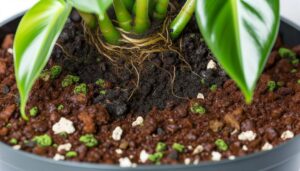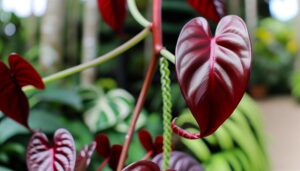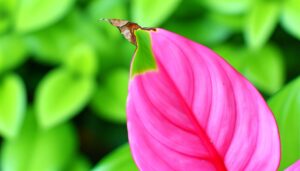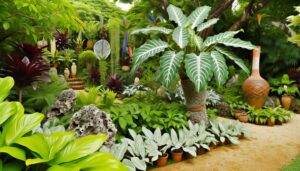What Is Philodendron Verrucosum Bosco?
Philodendron verrucosum ‘Bosco' is an enchanting species from the Araceae family, native to the tropical rainforests of Central and South America. It thrives as an epiphyte, utilizing aerial roots to cling to tree trunks in its natural habitat.
This plant is prized for its velvety leaves featuring vibrant color patterns and intricate veining. Best growth conditions include temperatures of 18-26°C (64-79°F), high humidity (60%-80%), and bright, indirect light.
Proper care involves consistent watering, well-draining soil, and regular feeding. Ensuring these conditions will help you appreciate this plant's distinctive beauty and fascinating characteristics.
Discover more details and care tips.
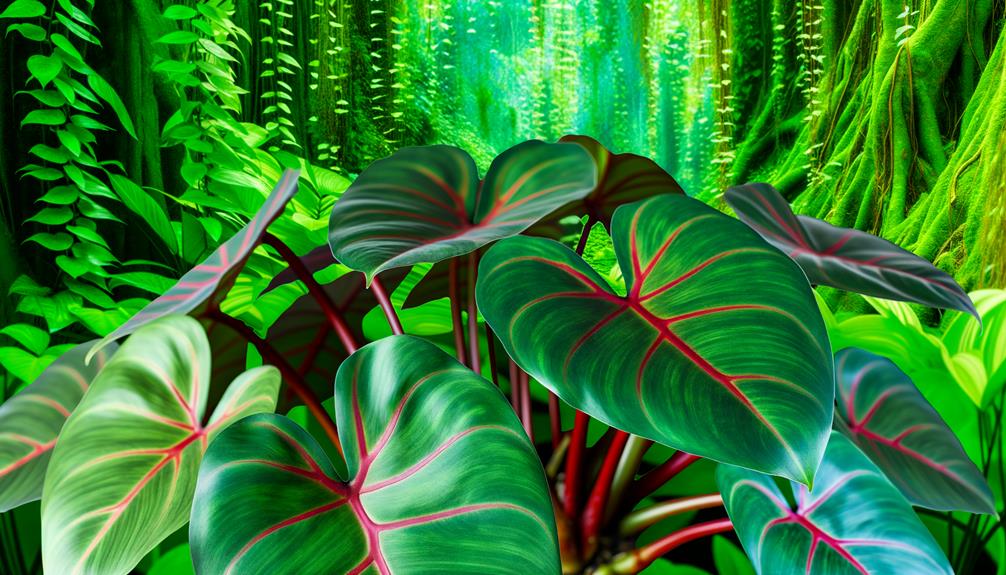
Key Takeaways
- Philodendron Verrucosum Bosco is a tropical epiphytic plant from Central and South American rainforests.
- It features velvety leaves with vibrant color patterns and intricate veining.
- It thrives in high humidity, bright indirect light, and well-draining organic soil.
- It uses aerial roots to cling to tree trunks in its native habitat.
- Popular among plant enthusiasts for its unique appearance and tactile appeal.
Origin and Background
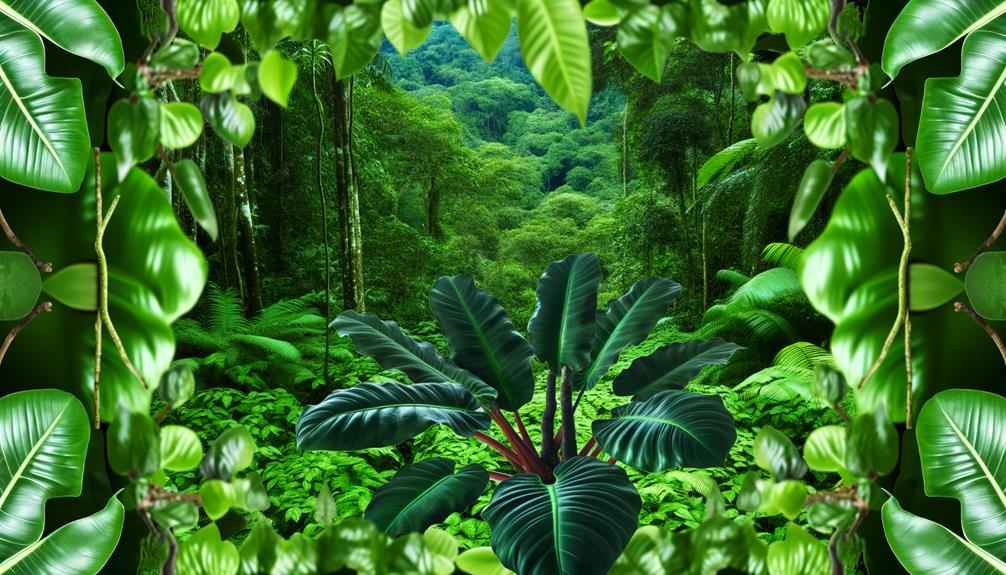
Philodendron verrucosum Bosco, a striking member of the Araceae family, originates from the tropical rainforests of Central and South America. This region, characterized by high humidity and consistent rainfall, provides an ideal environment for the growth of this epiphytic plant.
Thriving under the dense canopy, Philodendron verrucosum Bosco clings to tree trunks using aerial roots, benefiting from the filtered sunlight and rich organic matter. The species exhibits a remarkable adaptability to different elevations within its native range, from lowland forests to mountainous regions.
These environmental conditions have shaped its unique physiological traits, enabling it to flourish in diverse microhabitats. Understanding its origin provides critical insights into its care requirements and ecological significance in its native habitat.
Distinctive Features
Philodendron verrucosum 'Bosco' exhibits a remarkable leaf texture characterized by a velvety surface, which is both visually striking and tactilely appealing.
The foliage showcases vibrant color patterns, ranging from deep emerald green to vivid shades of red and maroon, often highlighted by intricate veining.
These distinctive features not only enhance its aesthetic value but also contribute to its popularity among plant enthusiasts and collectors.
Unique Leaf Texture
The leaves of Philodendron verrucosum 'Bosco' display a unique texture characterized by a soft surface and prominent, contrasting veins that enhance its visual appeal and tactile experience. This distinct texture results from the presence of fine trichomes and specialized leaf tissue structure.
The following attributes further define its unique leaf texture:
- Soft Surface: The upper leaf surface is covered with delicate, minute trichomes, giving a soft feel.
- Distinct Veins: Clearly outlined veins, often in contrasting colors, provide structural and aesthetic interest.
- Textural Variation: The interaction between the smooth vein ridges and the soft leaf surface creates a dynamic tactile sensation.
- Strength: The leaf's strong structure, supported by these veins, guarantees resilience against physical stress.
This combination of features makes Philodendron verrucosum 'Bosco' a standout specimen in any botanical collection.
Vibrant Color Patterns
Exhibiting a dynamic interplay of colors, the leaves of Philodendron verrucosum 'Bosco' feature striking patterns that range from deep emerald greens to vibrant reds and purples, accentuated by the contrasting veins. These chromatic variations are not merely superficial but are a hallmark of its distinctive morphology, contributing to its botanical allure. The leaf surface often displays a velvety texture, enhancing the visual depth and complexity of the color patterns.
| Leaf Color | Description |
|---|---|
| Emerald Green | Dominant base color |
| Vibrant Red | Prominent in new growth |
| Subtle Purple | Accentuates veins and edges |
Such vibrant pigmentation is pivotal for those seeking a visually stimulating addition to their botanical collection.
Ideal Growing Conditions
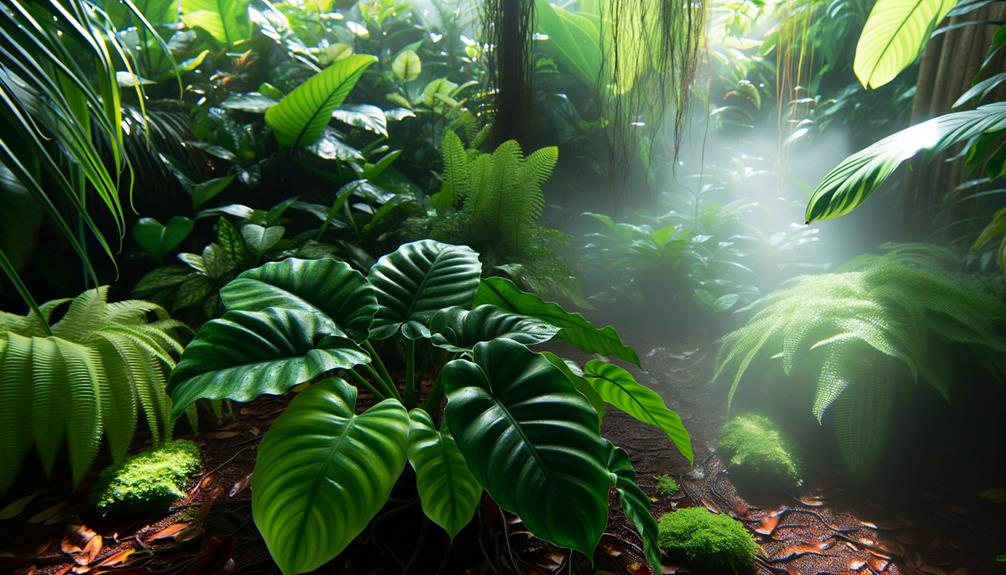
Ensuring ideal growth for Philodendron verrucosum 'Bosco' involves maintaining specific environmental conditions, including temperature, humidity, light, and soil parameters. This tropical species thrives when mimicking its native rainforest habitat. Key considerations are:
- Temperature: Maintain a consistent range between 18°C to 26°C (64°F to 79°F). Avoid sudden temperature fluctuations which can stress the plant.
- Humidity: High humidity levels (60%-80%) are essential. Employ humidifiers or place the plant on a humidity tray to achieve this.
- Light: Provide bright, indirect light. Direct sunlight can scorch the delicate leaves, while inadequate light may stunt growth.
- Soil: Utilize a well-draining, aerated soil mix rich in organic matter. A combination of peat, perlite, and orchid bark ensures optimal root health and moisture retention.
Watering and Feeding
Proper hydration and nutrient provision are critical for maintaining the health of Philodendron verrucosum 'Bosco'. Watering should be conducted when the top inch of the soil feels dry to the touch, ensuring the soil remains moist but not waterlogged.
Additionally, a balanced liquid fertilizer, applied bi-monthly during the growing season, will support the plant's nutritional requirements.
Optimal Watering Frequency
Determining the most suitable watering frequency for Philodendron verrucosum 'Bosco' requires careful consideration of its native habitat conditions and specific moisture needs. Originating from the humid rainforests of Central and South America, this species thrives in consistently moist, but not waterlogged, substrates.
To achieve the most appropriate watering:
- Consistent Moisture: Keep the soil consistently moist, similar to a wrung-out sponge, ensuring no standing water.
- Well-Draining Soil: Utilize a well-draining potting mix with components such as perlite and orchid bark to prevent root rot.
- Humidity Maintenance: Regular misting can help replicate the high humidity levels of its native environment.
- Seasonal Adjustments: Reduce watering frequency during the plant's dormant period in winter, while increasing it during active growth phases in spring and summer.
Nutrient Requirements
Philodendron verrucosum 'Bosco' requires a balanced nutrient regimen, encompassing both appropriate watering practices and regular feeding with a suitable fertilizer to maintain ideal growth and foliage vibrancy. Optimum watering involves maintaining consistent soil moisture without waterlogging, as excessive water can lead to root rot (Phytophthora spp.). Employing a well-draining substrate aids in this balance.
For feeding, a balanced, water-soluble fertilizer with an N-P-K ratio of 20-20-20 is recommended bi-monthly during the growing season. Micronutrients such as magnesium (Mg) and calcium (Ca) are essential for chlorophyll production and cell wall integrity, respectively. During dormancy, reduce feeding frequency to prevent nutrient buildup. Implementing these practices ensures the robust health and striking appearance of Philodendron verrucosum 'Bosco'.
Common Problems
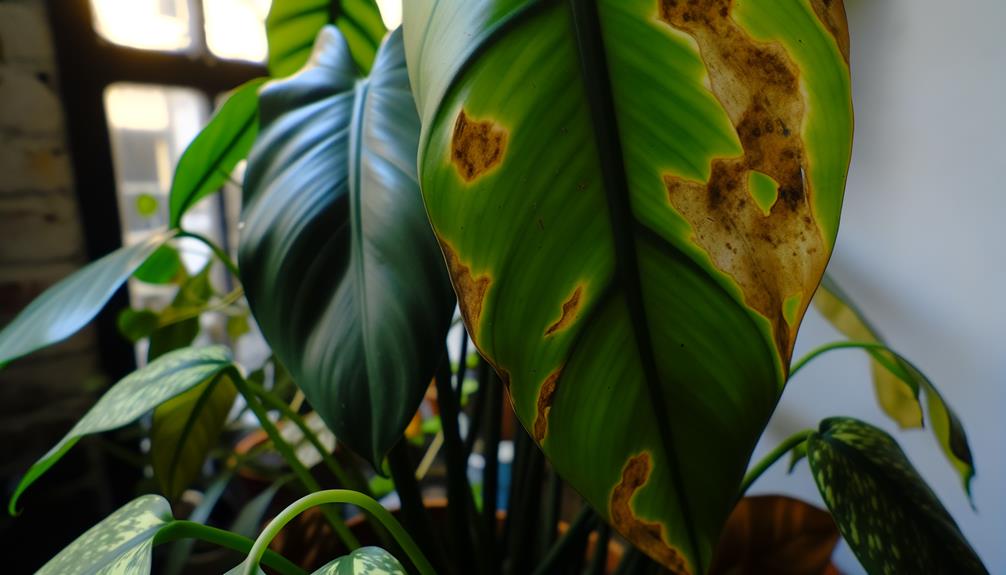
Identifying common problems in Philodendron verrucosum Bosco often involves recognizing issues related to pest infestations, inadequate lighting, and improper watering practices. These factors can have a significant impact on the plant's health and vigor.
Here are key problems to watch for:
- Pest Infestations: Spider mites (Tetranychus urticae) and aphids (Aphidoidea) can cause foliage damage, leading to yellowing and distortion.
- Inadequate Lighting: Insufficient light can result in leggy growth and pale leaves, detracting from the plant's aesthetic appeal.
- Improper Watering: Overwatering can lead to root rot caused by pathogens such as Pythium spp., while underwatering can cause leaf curling and browning.
- Humidity Levels: Low humidity can result in leaf browning and tissue desiccation, hampering the plant's overall health.
Understanding these issues enables proactive maintenance and care.
Propagation Tips
Addressing common problems guarantees a healthy *Philodendron verrucosum* Bosco, which is essential when considering propagation through methods such as stem cuttings and air layering. Stem cuttings involve selecting a healthy stem section with nodes, cutting it, and placing it in water or a moist substrate. Air layering, on the other hand, requires wounding a stem and wrapping it with moist sphagnum moss until roots form. Both methods are effective for this species given the right conditions.
| Method | Advantages | Disadvantages |
|---|---|---|
| Stem Cuttings | Simplicity, Quick Rooting | Requires Healthy Stem |
| Air Layering | High Success Rate, Less Stress | Time-Consuming |
| Water Propagation | Visual Root Monitoring | Risk of Root Rot |
| Substrate Propagation | Higher Root Development | Requires Proper Moisture Control |
Understanding these techniques ensures successful propagation of *Philodendron verrucosum* Bosco.
Conclusion
Philodendron verrucosum 'Bosco' represents a remarkable addition to the botanical realm, distinguished by its vibrant veined leaves and unique textures. This tropical plant thrives in humid environments with indirect light, needing regular moisture and balanced fertilization. However, vulnerability to pests and diseases requires careful attention.
Propagation mainly occurs through stem cuttings. The alluring traits of Philodendron verrucosum 'Bosco' emphasize its attractiveness, making it a preferred choice among horticultural enthusiasts and collectors.

